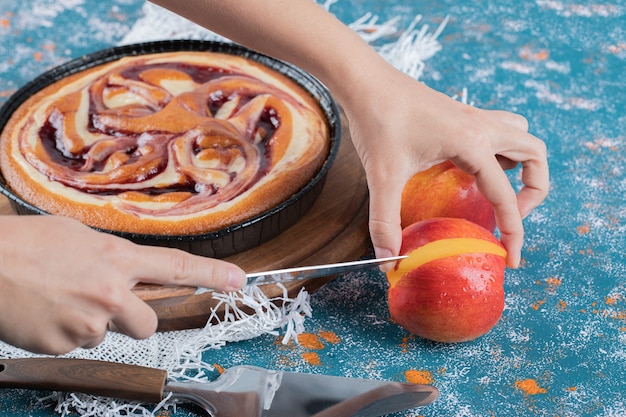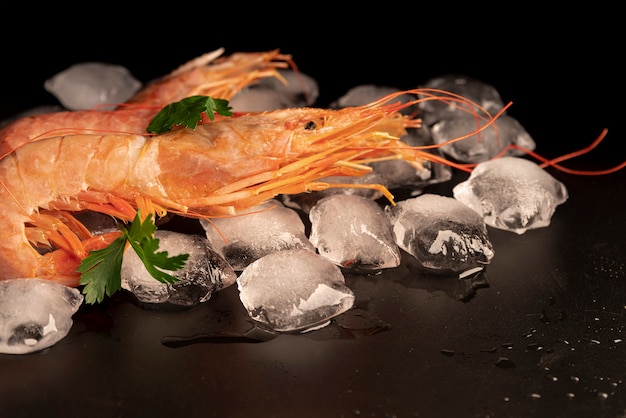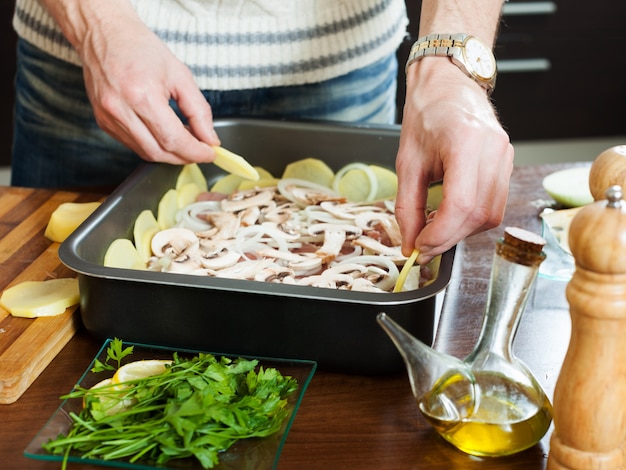(Part 1) The Science of cooking shrimp: Unraveling the Protein Mystery

Understanding Protein Coagulation: From Raw to Firm
Think of raw shrimp as bundles of proteins, and when you heat them, these proteins start to unravel and bind to each other. This binding is what gives the shrimp its firm texture. Too much heat, and the proteins bond too tightly, making the shrimp rubbery and tough. You know the feeling – nobody wants that! It’s like when you overcook an egg - the yolk becomes hard and rubbery instead of soft and runny.
The Perfect Bite: It's All About Texture and Flavor
The goal is to cook the shrimp just enough to create those bonds, making them firm and juicy, but not so much that they become dry and tough. You want that perfect bite – the kind that melts in your mouth and leaves you wanting more. And it's not just about texture; it's about flavor too. Overcooked shrimp loses its natural sweetness and delicate flavor, while perfectly cooked shrimp bursts with deliciousness.
(Part 2) shrimp size Matters: A Guide to Different Categories

Categorizing Shrimp: From Colossal to Extra Small
Here’s a quick guide to the different sizes, based on the number of shrimp per pound, so you know what to expect:
- Colossal: 10 to 12 shrimp per pound - These are the big boys, and they need a little more time to cook. They're perfect for grilling or baking, where they have a chance to really soak up flavor.
- Jumbo: 16 to 20 shrimp per pound - Still big and impressive, these will need a few more minutes than smaller shrimp. They're great for pan-frying or sautéing, where you can get a nice, crispy exterior.
- Large: 21 to 25 shrimp per pound - A classic size, these are easy to cook and work with. They're perfect for almost any cooking method, from stir-frying to adding to pasta dishes.
- Medium: 26 to 30 shrimp per pound - These are smaller, so they’ll cook quickly. They're perfect for dishes where you want a quick and easy protein, like stir-fries or pasta.
- Small: 31 to 40 shrimp per pound - These are great for quick and easy dishes, like stir-fries or pasta. They cook fast, so they're ideal for dishes where you don't want to overcook them.
- Extra Small: 41 to 50 shrimp per pound - Tiny and delicate, these are great for snacking or topping dishes. They're often used in salads or as a garnish, where their small size adds a delicate touch.
(Part 3) Cooking Methods and Timing: Finding the Perfect Match

Grilling: That Smoky, Charred Goodness
Grilling shrimp is all about achieving that delicious char. But be careful not to overcook them!
- Small to Medium Shrimp: 2-3 minutes per side.
- Large to Colossal Shrimp: 3-4 minutes per side.
Pan-Frying: Sizzling Flavor in a Flash
Pan-frying is a quick and easy way to cook shrimp, and it's perfect for adding lots of flavour. The high heat creates a crispy exterior while keeping the shrimp moist and tender inside.
- Small to Medium Shrimp: 2-3 minutes total.
- Large to Colossal Shrimp: 3-4 minutes total.
Boiling: A Classic Method for seafood boils
Boiling shrimp is a classic method, especially for seafood boils. The shrimp will cook quickly in boiling water, making it a great option for a crowd-pleasing meal.
- Small to Medium Shrimp: 2-3 minutes.
- Large to Colossal Shrimp: 3-4 minutes.
Baking: Flavorful and Easy
Baking shrimp is a great way to cook them in a flavorful sauce or marinade. The oven heat cooks the shrimp evenly, while the marinade adds a delicious layer of flavor.
- Small to Medium Shrimp: 10-12 minutes at 400°F (200°C).
- Large to Colossal Shrimp: 12-15 minutes at 400°F (200°C).
Sautéing: Quick, Simple, and Delicious
Sautéing shrimp is a quick and easy way to cook them with minimal fuss. It's a great option for weeknight meals or when you're short on time.
- Small to Medium Shrimp: 2-3 minutes total.
- Large to Colossal Shrimp: 3-4 minutes total.
(Part 4) Signs of Perfectly Cooked Shrimp: The Telltale Signs
How do you know when they're ready? Well, there are a few telltale signs. First, the colour. As the shrimp cook, their flesh will turn from translucent and grayish to an opaque, pink or white. You’ll also notice the shrimp begin to curl up, that's a sign they are cooked through.Don't Forget the internal temperature: For the Ultimate Assurance
And if you really want to be sure, you can use a meat thermometer. The internal temperature of cooked shrimp should reach 145°F (63°C).
(Part 5) The Importance of Doneness: Safety and Flavor
This is crucial, you know, because undercooked shrimp can be a bit of a health hazard. The good news is that it's very easy to tell when shrimp are cooked through. They will turn opaque, pink or white in colour, and curl up.Avoid Overcooking: The Enemy of tender shrimp
But remember, overcooking is a real threat. Shrimp quickly become rubbery and dry. So keep a close eye on them, and don’t overcook them. Overcooked shrimp is like a sad, rubbery shadow of its former self – not a happy culinary experience.
(Part 6) tips for cooking shrimp: Taking Your Shrimp Game to the Next Level
Okay, so we've covered the basics. Now let’s talk about a few tips that will take your shrimp game to the next level. These are the little things that make all the difference, from ensuring even cooking to achieving those amazing flavors.Start With Cold Shrimp: Consistency is Key
You always want to start with cold shrimp. This helps them cook more evenly. If you are using frozen shrimp, make sure to thaw them completely before cooking. Think of it as giving them a chance to "relax" before they hit the heat.
Pat Dry the Shrimp: Goodbye Sogginess
Patting the shrimp dry with a paper towel helps to prevent them from steaming in the pan, which can make them soggy. Plus, dry shrimp will get a lovely crispy exterior. Remember, we want that perfect balance of texture and flavor.
Don't Crowd the Pan: Give Them Space to Breathe
Make sure you don't overcrowd the pan, especially if you are pan-frying or sautéing. This will help prevent the shrimp from steaming and ensure they cook evenly. Think of it like a crowded party – if everyone is cramped together, it’s hard to move around and have a good time!
Use a High Heat: Quick and Even Cooking
Cooking shrimp over high heat will help them to cook quickly and evenly. But keep a close eye on them, because they can go from perfect to overcooked in a matter of seconds. It’s like a hot date – you need to be attentive and ready to react!
Add Salt and Pepper at the End: Flavor Bomb!
Salt and pepper are the perfect companions for shrimp, but be careful not to add them too soon. Salting them too early can draw out moisture, making them dry. Wait until the end for those flavour bursts. It's like saving the best for last!
Don't Overcook: The Golden Rule
The biggest mistake people make when cooking shrimp is overcooking them. You can always cook them a little longer if needed, but you can't take back overcooking. So, err on the side of undercooking, especially if you're a beginner. It's better to have a slightly undercooked shrimp than a tough, rubbery one!
(Part 7) Shrimp Cooking Time Chart: A Quick Reference Guide
Let's make this easy for you. Here's a handy chart summarizing the cooking times for different shrimp sizes and cooking methods. This is your go-to guide for perfect shrimp every time!| Shrimp Size | Grilling | Pan-Frying | Boiling | Baking | Sautéing |
|---|---|---|---|---|---|
| Small to Medium | 2-3 minutes per side | 2-3 minutes total | 2-3 minutes | 10-12 minutes at 400°F (200°C) | 2-3 minutes total |
| Large to Colossal | 3-4 minutes per side | 3-4 minutes total | 3-4 minutes | 12-15 minutes at 400°F (200°C) | 3-4 minutes total |
(Part 8) Beyond the Basics: Exploring Delicious shrimp recipes
Okay, now we're getting into the fun stuff. Shrimp can be so versatile! Let's explore some of the exciting ways you can prepare them. From classic dishes to creative culinary adventures, there's a shrimp recipe for everyone!shrimp scampi: A Classic for a Reason
Classic, simple, and always a hit, shrimp scampi is a dish that is sure to please. The shrimp are sautéed in garlic, white wine, and butter, creating a rich and flavorful sauce that's just perfect for pasta or bread. It’s a truly timeless combination of flavors that everyone loves.
grilled shrimp Skewers: Summertime Perfection
Grilled shrimp skewers are perfect for summer barbecues or a quick and easy weeknight dinner. Just thread the shrimp onto skewers with your favorite vegetables, like bell peppers, onions, or zucchini, and grill until they are cooked through. The smoky char adds a delicious flavor, and it’s a great way to showcase your grill skills.
shrimp tacos: A Flavorful Fiesta in a Tortilla
Shrimp tacos are a delicious and easy way to enjoy shrimp. Just cook the shrimp in a flavorful marinade, like lime juice, chili powder, and cumin, and then serve them in tortillas with your favorite toppings, like salsa, avocado, and cilantro. It’s a fun and satisfying dish that’s perfect for a casual meal or a party.
Shrimp Stir-Fry: A Fusion of Flavors
Shrimp stir-fry is a quick and easy way to enjoy shrimp with a variety of vegetables. Just cook the shrimp in a wok with your favorite stir-fry ingredients, like broccoli, carrots, and snap peas. It’s a great way to get your veggies in and enjoy a healthy and flavorful meal.
shrimp pasta: A Delicious comfort food
Shrimp pasta is a delicious and easy way to enjoy shrimp. Just cook the shrimp in a flavorful sauce, like tomato sauce, alfredo sauce, or pesto, and then toss it with your favorite pasta. It’s a classic comfort food that's always a crowd-pleaser.
(Part 9) FAQs: Your Shrimp Cooking Questions Answered
Here are some of the most common questions about shrimp cooking, so you can feel confident in your shrimp-cooking abilities:1. What’s the best way to tell if shrimp is cooked through?
The best way to tell if shrimp is cooked through is to look for a change in colour. Cooked shrimp will be opaque and pink or white, whereas raw shrimp will be translucent and grayish. Also, cooked shrimp will curl up. If you’re unsure, you can always use a meat thermometer. The internal temperature of cooked shrimp should reach 145°F (63°C).
2. What happens if I overcook shrimp?
Overcooked shrimp will be tough and rubbery. It's important to cook them quickly and evenly to avoid overcooking. If you do overcook them, there's not much you can do to salvage them, unfortunately. They’ll be dry and lack that juicy, flavorful texture we all crave.
3. Can I use frozen shrimp to make a shrimp scampi?
Absolutely! You can use frozen shrimp to make a delicious shrimp scampi. Just make sure to thaw them completely before cooking. Frozen shrimp may take a little longer to cook, so adjust the cooking time accordingly. No need to worry about using frozen shrimp - it's a great option for convenience and flavor.
4. How can I prevent shrimp from sticking to the pan?
To prevent shrimp from sticking to the pan, make sure to heat the pan over high heat and add a little bit of oil or butter. Also, make sure to pat the shrimp dry before cooking. If the shrimp are still sticking to the pan, you can try adding a little more oil or butter. The key is to get that pan nice and hot, and the shrimp dry, so they sizzle beautifully instead of sticking.
5. What are some good seasonings for shrimp?
Shrimp is a great blank canvas for flavour, so feel free to experiment! Classic choices include salt, pepper, garlic, lemon juice, chili powder, cumin, paprika, and oregano. You can also use herbs like parsley, cilantro, dill, and thyme. Don’t be afraid to get creative and try new combinations – the possibilities are endless!
Everyone is watching

How to Cook Frozen Lobster Tails Perfectly: A Step-by-Step Guide
RecipesLobster. Just the word conjures up images of lavish meals, special occasions, and a taste of luxury. But let's...

Pigs in a Blanket Cooking Time: How Long to Bake for Perfect Results
RecipesAh, pigs in a blanket. Just the name conjures up images of those delightful little parcels of crispy pastry en...

Pork Fillet Cooking Time: How Long to Cook It Perfectly
RecipesPork fillet, or tenderloin as it's sometimes called, is a real favourite in our house. It's so versatile, and...

The Ultimate Guide to Cooking Delicious Frankfurters
RecipesLet's face it, we all love a good frankfurter. It's a classic, simple, and always satisfying. But let's be rea...

Wolf Meat Recipes: A Guide to Cooking Wild Game
RecipesLet's be honest, you don't see wolf meat at your local butcher shop every day. It's a bit of a wild card, but ...
